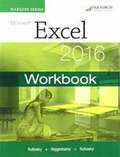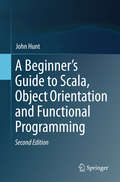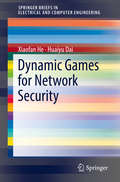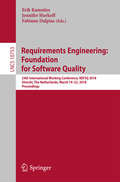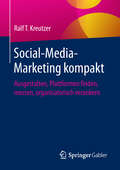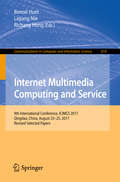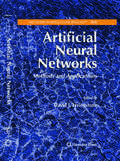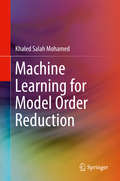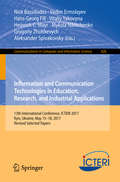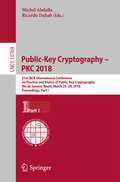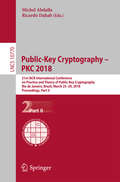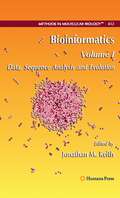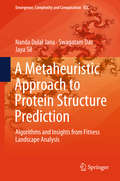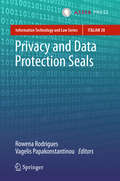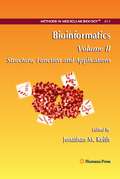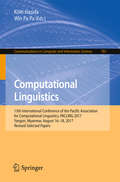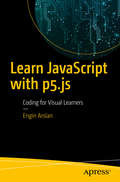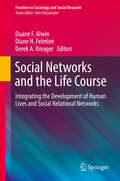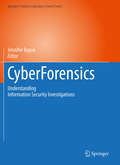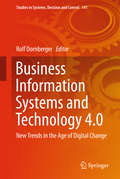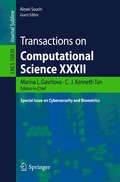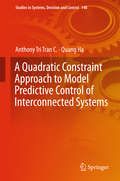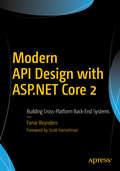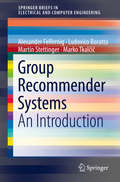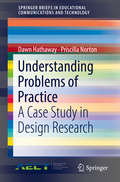- Table View
- List View
Microsoft® Excel® 2016 Workbook (Marquee Series)
by Nita Rutkosky Audrey Roggenkamp Ian RutkoskyMarquee Series: Microsoft Excel 2016 offers a highly visual, hands-on approach to learning Microsoft Excel. Ideal for 1 or 2 credit courses, this text facilitates self-paced, accelerated, and traditional learning formats.
A Beginner's Guide to Scala, Object Orientation and Functional Programming
by John HuntScala is now an established programming language developed by Martin Oderskey and his team at the EPFL. The name Scala is derived from Sca(lable) La(nguage). Scala is a multi-paradigm language, incorporating object oriented approaches with functional programming. Although some familiarity with standard computing concepts is assumed (such as the idea of compiling a program and executing this compiled from etc.) and with basic procedural language concepts (such as variables and allocation of values to these variables) the early chapters of the book do not assume any familiarity with object orientation nor with functional programming These chapters also step through other concepts with which the reader may not be familiar (such as list processing). From this background, the book provides a practical introduction to both object and functional approaches using Scala. These concepts are introduced through practical experience taking the reader beyond the level of the language syntax to the philosophy and practice of object oriented development and functional programming. Students and those actively involved in the software industry will find this comprehensive introduction to Scala invaluable.
Dynamic Games for Network Security (Springerbriefs In Electrical And Computer Engineering)
by Xiaofan He Huaiyu DaiThe goal of this SpringerBrief is to collect and systematically present the state-of-the-art in this research field and the underlying game-theoretic and learning tools to the broader audience with general network security and engineering backgrounds. Particularly, the exposition of this book begins with a brief introduction of relevant background knowledge in Chapter 1, followed by a review of existing applications of SG in addressing various dynamic network security problems in Chapter 2. A detailed treatment of dynamic security games with information asymmetry is given in Chapters 3–5. Specifically, dynamic security games with extra information that concerns security competitions, where the defender has an informational advantage over the adversary are discussed in Chapter 3. The complementary scenarios where the defender lacks information about the adversary is examined in Chapter 4 through the lens of incomplete information SG. Chapter 5 is devoted to the exploration of how to proactively create information asymmetry for the defender’s benefit.The primary audience for this brief includes network engineers interested in security decision-making in dynamic network security problems. Researchers interested in the state-of-the-art research on stochastic game theory and its applications in network security will be interested in this SpringerBrief as well. Also graduate and undergraduate students interested in obtaining comprehensive information on stochastic game theory and applying it to address relevant research problems can use this SpringerBrief as a study guide. Lastly, concluding remarks and our perspective for future works are presented in Chapter 6.
Requirements Engineering: 24th International Working Conference, Refsq 2018, Utrecht, The Netherlands, March 19-22, 2018, Proceedings (Lecture Notes in Computer Science #10753)
by Erik Kamsties Jennifer Horkoff Fabiano DalpiazThis book constitutes the proceedings of the 24th International Working Conference on Requirements Engineering - Foundation for Software Quality, REFSQ 2018, held in Utrecht, The Netherlands, in March 2018. The 23 full and 2 invited talks papers presented in this volume were carefully reviewed and selected from 57 submissions. The papers were organized in topical sections named: RE in Industrial Practice; NLP in Theory and Practice; Empirical Insights into Traceability; Taming Ambiguity; Large-Scale RE; Quality Requirements; User and Job Stories; Requirements Alignment; RE Previews and Visions; Big Data; Mindmapping and Requirements Modeling.
Social-Media-Marketing kompakt
by Ralf T. KreutzerDieses Buch verdeutlicht, dass Social-Media-Marketing heute zu einem integralen Bestandteil der Online-Kommunikation geworden ist. Doch welche Ziele lassen sich damit erreichen? Welche Plattformen bieten welche Möglichkeiten? Wie kann der Erfolg einer Social-Media-Kampagne gemessen werden? Von welchen Plattformen sollte man die Finger lassen? Welche Erfolgsfaktoren zählen? Welche Social-Media-KPIs sind relevant? Ist Social-Media-Marketing gut für meine Suchmaschinen-Optimierung? In diesem Werk werden alle zentralen Fragen zum Social-Media-Marketing kompetent beantwortet.
Internet Multimedia Computing and Service: 9th International Conference, Icimcs 2017, Qingdao, China, August 23-25, 2017, Revised Selected Papers (Communications In Computer And Information Science #819)
by Benoit Huet Liqiang Nie Richang HongThis book constitutes the refereed proceedings of the 9th International Conference on Internet Multimedia Computing and Service, ICIMCS 2017, held in Qingdao, China, in August 2017. The 20 revised full papers and 28 revised short papers presented were carefully reviewed and selected from 103 submissions. The papers are organized in topical sections on multimedia information fusion, image processing and object recognition, machine learning and representation learning, multimedia retrieval, poster papers.
Artificial Neural Networks: Methods and Applications (Methods in Molecular Biology #458)
by David J. LivingstoneIn this book, international experts report the history of the application of ANN to chemical and biological problems, provide a guide to network architectures, training and the extraction of rules from trained networks, and cover many cutting-edge examples of the application of ANN to chemistry and biology. Methods involving the mapping and interpretation of Infra Red spectra and modelling environmental toxicology are included. This book is an excellent guide to this exciting field.
Machine Learning for Model Order Reduction
by Khaled Salah MohamedThis Book discusses machine learning for model order reduction, which can be used in modern VLSI design to predict the behavior of an electronic circuit, via mathematical models that predict behavior. The author describes techniques to reduce significantly the time required for simulations involving large-scale ordinary differential equations, which sometimes take several days or even weeks. This method is called model order reduction (MOR), which reduces the complexity of the original large system and generates a reduced-order model (ROM) to represent the original one. Readers will gain in-depth knowledge of machine learning and model order reduction concepts, the tradeoffs involved with using various algorithms, and how to apply the techniques presented to circuit simulations and numerical analysis.Introduces machine learning algorithms at the architecture level and the algorithm levels of abstraction;Describes new, hybrid solutions for model order reduction;Presents machine learning algorithms in depth, but simply;Uses real, industrial applications to verify algorithms.
Information and Communication Technologies in Education, Research, and Industrial Applications: 11th International Conference, Icteri 2015, Lviv, Ukraine, May 14-16, 2015, Revised Selected Papers (Communications In Computer And Information Science #594)
by Nick Bassiliades Vadim Ermolayev Hans-Georg Fill Vitaliy Yakovyna Heinrich C. Mayr Mykola Nikitchenko Grygoriy Zholtkevych Aleksander SpivakovskyThis book contains extended versions of the best papers presented at the 13th International Conference on Information and Communication Technologies in Education, Research, and Industrial Applications, ICTERI 2017, held in Kyiv, Ukraine, in May 2017.The 11 revised full papers included in this volume were carefully reviewed and selected from 151 initial submissions during several rounds of reviewing. The papers are organized in the following topical sections: modeling and theoretical frameworks; ICT in teaching, learning, and education management; and ICT evaluation and applications.
Public-Key Cryptography – PKC 2018: 21st Iacr International Conference On Practice And Theory Of Public-key Cryptography, Rio De Janeiro, Brazil, March 25-29, 2018, Proceedings (Lecture Notes in Computer Science #10770)
by Michel Abdalla Ricardo DahabThe two-volume set LNCS 10769 and 10770 constitutes the refereed proceedings of the 21st IACR International Conference on the Practice and Theory of Public-Key Cryptography, PKC 2018, held in Rio de Janeiro, Brazil, in March 2018. The 49 revised papers presented were carefully reviewed and selected from 186 submissions. They are organized in topical sections such as Key-Dependent-Message and Selective-Opening Security; Searchable and Fully Homomorphic Encryption; Public-Key Encryption; Encryption with Bad Randomness; Subversion Resistance; Cryptanalysis; Composable Security; Oblivious Transfer; Multiparty Computation; Signatures; Structure-Preserving Signatures; Functional Encryption; Foundations; Obfuscation-Based Cryptographic Constructions; Protocols; Blockchain; Zero-Knowledge; Lattices.
Public-Key Cryptography – PKC 2018: 21st Iacr International Conference On Practice And Theory Of Public-key Cryptography, Rio De Janeiro, Brazil, March 25-29, 2018, Proceedings (Lecture Notes in Computer Science #10770)
by Michel Abdalla Ricardo DahabThe two-volume set LNCS 10769 and 10770 constitutes the refereed proceedings of the 21st IACR International Conference on the Practice and Theory of Public-Key Cryptography, PKC 2018, held in Rio de Janeiro, Brazil, in March 2018. The 49 revised papers presented were carefully reviewed and selected from 186 submissions. They are organized in topical sections such as Key-Dependent-Message and Selective-Opening Security; Searchable and Fully Homomorphic Encryption; Public-Key Encryption; Encryption with Bad Randomness; Subversion Resistance; Cryptanalysis; Composable Security; Oblivious Transfer; Multiparty Computation; Signatures; Structure-Preserving Signatures; Functional Encryption; Foundations; Obfuscation-Based Cryptographic Constructions; Protocols; Blockchain; Zero-Knowledge; Lattices.
Bioinformatics: Volume I: Data, Sequence Analysis and Evolution (Methods in Molecular Biology #452)
by Jonathan M. KeithIn this book, leading researchers in the field of Bioinformatics provide a selection of the most useful and widely applicable methods, able to be applied as is, or with minor variations, to many specific problems. Over 80 authors from around the globe contribute to the two volumes, including many leading experts in their respective subjects. They encompass topics from across the diverse field of bioinformatics through its broad scope, combining to provide an inter-disciplinary collaboration involving biologists, biochemists, physicists, mathematicians, statisticians and computer scientists.
A Metaheuristic Approach to Protein Structure Prediction: Algorithms And Insights From Fitness Landscape Analysis (Emergence, Complexity And Computation Ser. #31)
by Nanda Dulal Jana Swagatam Das Jaya SilThis book introduces characteristic features of the protein structure prediction (PSP) problem. It focuses on systematic selection and improvement of the most appropriate metaheuristic algorithm to solve the problem based on a fitness landscape analysis, rather than on the nature of the problem, which was the focus of methodologies in the past. Protein structure prediction is concerned with the question of how to determine the three-dimensional structure of a protein from its primary sequence. Recently a number of successful metaheuristic algorithms have been developed to determine the native structure, which plays an important role in medicine, drug design, and disease prediction. This interdisciplinary book consolidates the concepts most relevant to protein structure prediction (PSP) through global non-convex optimization. It is intended for graduate students from fields such as computer science, engineering, bioinformatics and as a reference for researchers and practitioners.
Privacy and Data Protection Seals (Information Technology and Law Series #28)
by Rowena Rodrigues Vagelis PapakonstantinouThe book presents timely and needed contributions on privacy and data protection seals as seen from general, legal, policy, economic, technological, and societal perspectives. It covers data protection certification in the EU (i.e., the possibilities, actors and building blocks); the Schleswig-Holstein Data Protection Seal; the French Privacy Seal Scheme; privacy seals in the USA, Europe, Japan, Canada, India and Australia; controversies, challenges and lessons for privacy seals; the potential for privacy seals in emerging technologies; and an economic analysis. This book is particularly relevant in the EU context, given the General Data Protection Regulation (GDPR) impetus to data protection certification mechanisms and the dedication of specific provisions to certification. Its coverage of practices in jurisdictions outside the EU also makes it relevant globally. This book will appeal to European legislators and policy-makers, privacy and data protection practitioners, certification bodies, international organisations, and academics.Rowena Rodrigues is a Senior Research Analyst with Trilateral Research Ltd. in London and Vagelis Papakonstantinou is a Senior Researcher at the Vrije Universiteit Brussel in Brussels.
Bioinformatics, Volume II: Volume II: Structure, Function and Applications (Methods in Molecular Biology #453)
by Jonathan M. KeithNot only is the quantity of life science data expanding, but new types of biological data continue to be introduced as a result of technological development and a growing understanding of biological systems. Methods for analyzing these data are an increasingly important component of modern biological research. In Bioinformatics, leading researchers in the field provide a selection of the most useful and widely applicable methods, able to be applied as is, or with minor variations, to many specific problems. Volume II: Structure, Function and Applications contains methods pertinent to the prediction of protein and RNA structures and the analysis and classification of structures, methods for inferring the function of previously identified genomic elements, chiefly protein-coding genes, medical applications in diagnostics and drug discovery, and "meta-methods" for developers of bioinformatics algorithms. As a volume of the highly successful Methods in Molecular Biology™ series, this work provides the kind of detailed description and implementation advice that is crucial for getting optimal results.<P><P> Comprehensive and cutting-edge, Bioinformatics: Volume II: Structure, Function and Applications is an ideal reference for all scientists involved with the ever-growing array of data in the expanding field of life science.
Computational Linguistics: 15th International Conference Of The Pacific Association For Computational Linguistics, Pacling 2017, Yangon, Myanmar, August 16-18, 2017, Revised Selected Papers (Communications In Computer And Information Science #781)
by Kôiti Hasida Win Pa PaThis book constitutes the refereed proceedings of the 15th International Conference of the Pacific Association for Computational Linguistics, PACLING 2017, held in Yangon, Myanmar, in August 2017.The 28 revised full papers presented were carefully reviewed and selected from 50 submissions. The papers are organized in topical sections on semantics and semantic analysis; statistical machine translation; corpora and corpus-based language processing; syntax and syntactic analysis; document classification; information extraction and text mining; text summarization; text and message understanding; automatic speech recognition; spoken language and dialogue; speech pathology; speech analysis.
Learn JavaScript with p5.js: Coding For Visual Learners
by Engin ArslanLearn coding from scratch in a highly engaging and visual manner using the vastly popular JavaScript with the programming library p5.js. The skills you will acquire from this book are highly transferable to a myriad of industries and can be used towards building web applications, programmable robots, or generative art. You'll gain the proper context so that you can build a strong foundation for programming. This book won’t hinder your momentum with irrelevant technical or theoretical points. The aim is to build a strong, but not overly excessive knowledge to get you up and running with coding. If you want to program creative visuals and bring that skill set to a field of your your choice, then Learn JavaScript with p5.js is the book for you.What You'll LearnCode from scratch and create computer graphics with JavaScript and the p5.js libraryGain the necessary skills to move into your own creative projectsCreate graphics and interactive experiences using ProcessingProgram using JavaScript and p5.js and secondarily in creating visualsWho This Book is ForArtists or a visual designers. Also, those who want to learn the fundamentals of programming through visual examples.
Social Networks and the Life Course: Integrating The Development Of Human Lives And Social Relational Networks (Frontiers In Sociology And Social Research Ser. #2)
by Duane F. Alwin Diane H. Felmlee Derek A. KreagerThis volume engages the interface between the development of human lives and social relational networks. It focuses on the integration of two subfields of sociology/social science--the life course and social networks. Research practitioners studying social networks typically focus on social structure or social organization, ignoring the complex lives of the people in those networks. At the same time, life course researchers tend to focus on individual lives without necessarily studying the contexts of social relationships in which lives are embedded and “linked” to one another through social networks. These patterns are changing and this book creates an audience of researchers who will better integrate the two subfields. It covers the role of social networks across the life span, from childhood and adolescence, to midlife, through old age.
CyberForensics: Understanding Information Security Investigations (Springer’s Forensic Laboratory Science Series)
by Jennifer BayukThis fascinating and highly topical subject has a history dating back to the secret world of 1970s Cold War espionage, when the US military and Central intelligence agencies, aided by the latest mainframe systems, were the first to use computer forensics techniques in counterintelligence. In the decades since, cybercrime has emerged from the obscurity of low-level prosecution evidence to become a serious cross-border crime issue, while cyberforensic investigators have moved on from drug, murder, and child pornography crimes that were facilitated by computers, and are now tackling headline-grabbing cyber bank robbery, identity theft, and corporate spying. With little consensus as yet on the qualifications required to become a cyberforensic investigator, Cyberforensics: Understanding Information Security Investigations assembles the varying perspectives of pioneers and key figures in the field. All the authors have more than 10 years' experience in successfully investigating cybercrime, and some more than 20. Through real-life case studies the chapters introduce the reader to the field of cybersecurity, starting with corporate investigation, and progressing to analyze the issues in more detail. Taking us from accounting cyberforensics to unraveling the complexities of malware, the contributors explain the tools and techniques they use in a manner that allows us to map their methodology into a more generic understanding of what a cybersecurity investigation really is. Above all, Cyberforensics shows that there is a cohesive set of concepts that binds cybersecurity investigators to a shared vision. These core ideas are now gaining importance as a body of knowledge that cyberforensics professionals agree should be a prerequisite to the professional practice of information security.
Business Information Systems and Technology 4.0: New Trends In The Age Of Digital Change (Studies In Systems, Decision And Control #141)
by Rolf DornbergerThis book discusses digitalization trends and their concrete applications in business and societal contexts. It summarizes new findings from research, teaching and management activities comprising digital transformation, e-business, the representation of knowledge, human–computer interaction and business optimization. The trends discussed include artificial intelligence, virtual reality, robotics, blockchain, and many more. Professors and researchers who conduct research and teach at the interface between academia and business present the latest advances in their field. The book adopts the philosophy of applied sciences and combines both rigorous research and practical applications. As such, it addresses the needs of both professors and researchers, who are constantly seeking inspiration, and of managers seeking to tap the potential of the latest trends to take their business to the next level. Readers will find answers to pressing questions that arise in their daily work.
Transactions on Computational Science XXXII: Special Issue On Cybersecurity And Biometrics (Lecture Notes in Computer Science #10830)
by Marina L. Gavrilova Alexei Sourin C.J. Kenneth TanThis, the 32nd issue of the Transactions on Computational Science, focusses on cybersecurity and biometrics. The eight detailed papers cover the following topics: Multimodal Warnings for Distracted Smartphone Users on the Move; EEG-Based Mental Workload and Stress Monitoring of Crew Members in a Maritime Virtual Simulator; Detecting Web Defacement and Enabling Web-Content Regeneration; Software as a Weapon in the Context of (Inter)national Security; Multi-user Architecture and Multi-player Games; An Adaptive Discrete Wavelet Transform Based Face Recognition Approach; Synthesizing Images of Imagined Faces Based on Relevance Feedback; and Neurofeedback Training to Enhance the Focused Attention of Elite Rifle Shooters.
A Quadratic Constraint Approach to Model Predictive Control of Interconnected Systems (Studies In Systems, Decision And Control #148)
by Anthony Tri Tran C. Quang HaThis book focuses on the stabilization and model predictive control of interconnected systems with mixed connection configurations. It introduces the concept of dissipation-based quadratic constraint for developing attractivity assurance methods for interconnected systems. In order to develop these methods, distributed and decentralized architectures are employed, whereby the communication between subsystems is fully connected, partially connected, or completely disconnected. Given that the control inputs are entirely or partially decoupled between subsystems and no additional constraints are imposed on the interactive variables beyond the coupling constraint itself, the proposed approaches can be used with various types of systems and applications. Further, the book describes how the effects of coupling delays and data losses in device networks are resolved. From a practical perspective, the innovations presented are of benefit in applications in a broad range of fields, including the process and manufacturing industries, networked robotics, and network-centric systems such as chemical process systems, power systems, telecommunication networks, transportation networks, and, no less importantly, supply chain automation.
Modern API Design with ASP.NET Core 2: Building Cross-platform Back-end Systems
by Fanie ReyndersUse ASP.NET Core 2 to create durable and cross-platform web APIs through a series of applied, practical scenarios. Examples in this book help you build APIs that are fast and scalable. You’ll progress from the basics of the framework through to solving the complex problems encountered in implementing secure RESTful services. The book is packed full of examples showing how Microsoft’s ground-up rewrite of ASP.NET Core 2 enables native cross-platform applications that are fast and modular, allowing your cloud-ready server applications to scale as your business grows. Major topics covered in the book include the fundamentals and core concepts of ASP.NET Core 2. You'll learn about building RESTful APIs with the MVC pattern using proven best practices and following the six principles of REST. Examples in the book help in learning to develop world-class web APIs and applications that can run on any platform, including Windows, Linux, and MacOS. You can even deploy to Microsoft Azure and automate your delivery by implementing Continuous Integration and Continuous Deployment pipelines.What You Will LearnIncorporate automated API tooling such as Swagger from the OpenAPI specificationStandardize query and response formats using Facebook’s GraphQL query languageImplement security by applying authentication and authorization using ASP.NET IdentityEnsure the safe storage of sensitive data using the data protection stackCreate unit and integration tests to guarantee code qualityWho This Book Is ForDevelopers who build server applications such as web sites and web APIs that need to run fast and cross platform; programmers who want to implement practical solutions for real-world problems; those who want in-depth knowledge of the latest bits of ASP.NET Core 2.0
Group Recommender Systems: An Introduction (Springerbriefs In Electrical And Computer Engineering)
by Alexander Felfernig Ludovico Boratto Martin Stettinger Marko TkalčičThis book presents group recommender systems, which focus on the determination of recommendations for groups of users. The authors summarize different technologies and applications of group recommender systems. They include an in-depth discussion of state-of-the-art algorithms, an overview of industrial applications, an inclusion of the aspects of decision biases in groups, and corresponding de-biasing approaches. The book includes a discussion of basic group recommendation methods, aspects of human decision making in groups, and related applications. A discussion of open research issues is included to inspire new related research. The book serves as a reference for researchers and practitioners working on group recommendation related topics.
Understanding Problems of Practice: A Case Study In Design Research (Springerbriefs In Educational Communications And Technology Ser.)
by Dawn Hathaway Priscilla NortonToday, K-12 practitioners are challenged to become educational innovators. Yet, little is available to the practitioner to guide their reflection about the design, development, and implementation of these innovations in their own practice. This brief approaches such problems of practice from the perspectives of design research. Although design research typically centers on the partnership between researchers and practitioners in real-world settings, relationships between researchers and practitioners are not always practical. In this brief, the authors explore how the design research process can make the goals, assumptions, processes, methods, and outcomes of design research uniquely accessible to the practitioner. In clear, explicit language, it introduces design research to practitioners using both expository discussions and a robust narrative case study approach that ably guides the reader through the phases of design research, namely:Theory to innovation to practiceUnderstanding problems of practiceCreating a design solutionAssessing the design solutionEvaluating learning outcomesCapturing lessons for practiceUnderstanding Problems of Practice is a singular resource for teachers and practitioners enrolled in graduate research courses or courses on teacher leadership. It also lends itself well as a supplement to professional development activities and studies at the district, school, and professional learning community levels.
